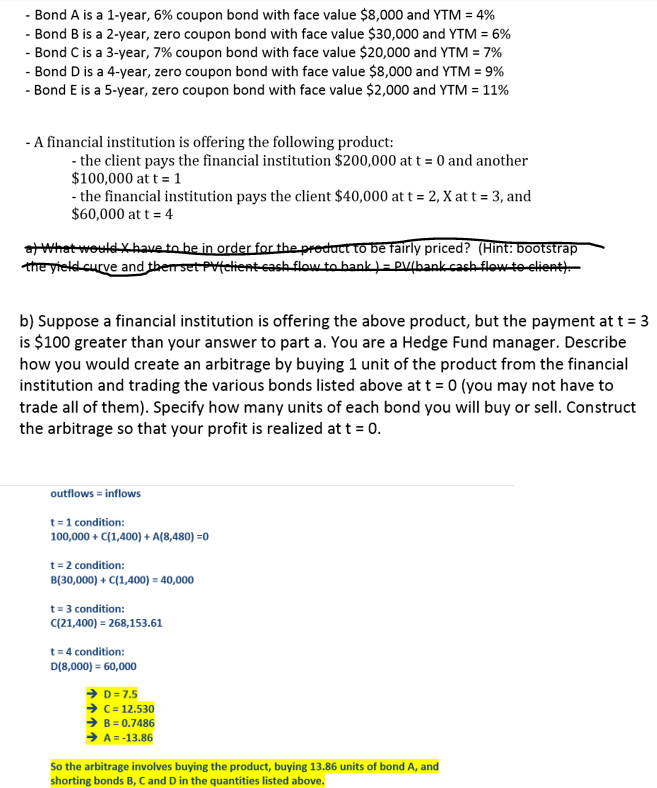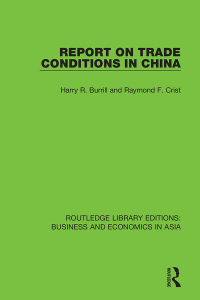Answered step by step
Verified Expert Solution
Question
1 Approved Answer
Can you please explain how can I get the answers shown above? Why does client pay the financial institution an outflow and bonds are

Can you please explain how can I get the answers shown above? Why does "client pay the financial institution " an outflow and "bonds" are outflow etc...
- Bond A is a 1-year, 6% coupon bond with face value $8,000 and YTM = 4% - Bond B is a 2-year, zero coupon bond with face value $30,000 and YTM = 6% - Bond C is a 3-year, 7% coupon bond with face value $20,000 and YTM = 7% - Bond D is a 4-year, zero coupon bond with face value $8,000 and YTM = 9% - Bond E is a 5-year, zero coupon bond with face value $2,000 and YTM = 11% - A financial institution is offering the following product: - the client pays the financial institution $200,000 at t = 0 and another $100,000 at t = 1 - the financial institution pays the client $40,000 at t = 2, X at t = 3, and $60,000 at t = 4 at What would have to be in order for the product to be fairly priced? (Hint: bootstrap the yield curve and therrset Putetient cash flow to bank) = PVfhank cash flow to cliente b) Suppose a financial institution is offering the above product, but the payment at t = 3 is $100 greater than your answer to part a. You are a Hedge Fund manager. Describe how you would create an arbitrage by buying 1 unit of the product from the financial institution and trading the various bonds listed above at t = 0 (you may not have to trade all of them). Specify how many units of each bond you will buy or sell. Construct the arbitrage so that your profit is realized at t = 0. outflows = inflows t = 1 condition: 100,000 + C(1,400) +A(8,480) =0 t=2 condition: B(30,000) + C(1,400) = 40,000 t = 3 condition: C(21,400) = 268,153.61 t = 4 condition: D(8,000) = 60,000 D = 7.5 C = 12.530 B = 0.7486 A=-13.86 So the arbitrage involves buying the product, buying 13.86 units of bond A, and shorting bonds B, C and D in the quantities listed above. - Bond A is a 1-year, 6% coupon bond with face value $8,000 and YTM = 4% - Bond B is a 2-year, zero coupon bond with face value $30,000 and YTM = 6% - Bond C is a 3-year, 7% coupon bond with face value $20,000 and YTM = 7% - Bond D is a 4-year, zero coupon bond with face value $8,000 and YTM = 9% - Bond E is a 5-year, zero coupon bond with face value $2,000 and YTM = 11% - A financial institution is offering the following product: - the client pays the financial institution $200,000 at t = 0 and another $100,000 at t = 1 - the financial institution pays the client $40,000 at t = 2, X at t = 3, and $60,000 at t = 4 at What would have to be in order for the product to be fairly priced? (Hint: bootstrap the yield curve and therrset Putetient cash flow to bank) = PVfhank cash flow to cliente b) Suppose a financial institution is offering the above product, but the payment at t = 3 is $100 greater than your answer to part a. You are a Hedge Fund manager. Describe how you would create an arbitrage by buying 1 unit of the product from the financial institution and trading the various bonds listed above at t = 0 (you may not have to trade all of them). Specify how many units of each bond you will buy or sell. Construct the arbitrage so that your profit is realized at t = 0. outflows = inflows t = 1 condition: 100,000 + C(1,400) +A(8,480) =0 t=2 condition: B(30,000) + C(1,400) = 40,000 t = 3 condition: C(21,400) = 268,153.61 t = 4 condition: D(8,000) = 60,000 D = 7.5 C = 12.530 B = 0.7486 A=-13.86 So the arbitrage involves buying the product, buying 13.86 units of bond A, and shorting bonds B, C and D in the quantities listed aboveStep by Step Solution
There are 3 Steps involved in it
Step: 1

Get Instant Access to Expert-Tailored Solutions
See step-by-step solutions with expert insights and AI powered tools for academic success
Step: 2

Step: 3

Ace Your Homework with AI
Get the answers you need in no time with our AI-driven, step-by-step assistance
Get Started


